Comments
Losing a Childhood Hero — Frank Howard
It’s tough to lose a childhood hero. Perhaps even more so when, in your mind’s eye, they are — or were — viewed as indestructible. To lose a childhood hero is to lose a bit of your childhood itself.
Frank Oliver Howard, outfielder and first baseman for the Washington Senators, passed this past Monday, October 30. He was 87 years old.
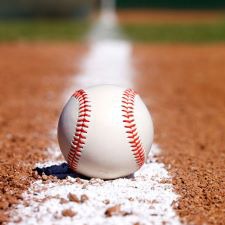
My lifetime adoration for the greatest of our games, baseball, started not just on dusty fields or by throwing complete games with a tennis ball against a brick wall outlined with a chalk strike zone. My early devotion to our National Pastime also grew from the stands as a fan(atic) of the woebegone Senators. Howard was my hero from that team from 1966-71, when the franchise moved from DC (and broke countless hearts) to become the Texas Rangers.
At 6’7″ and 255 pounds, Howard was the largest and strongest player of his era. Known alternatively and affectionately as Hondo, The Capital Punisher or The Washington Monument, few in his era could hit a ball farther or were a more feared presence in the batter’s box. Befitting his Popeye forearms, Howard swung one of the biggest bats in baseball — a 37-inch, 35-ounce Louisville Slugger.
For a four-year stretch (1967 through 1970), he was, arguably, with perennial HR champ Harmon Killebrew, the most feared slugger in the game. Killebrew won the AL home run title in 1967 with 44 round-trippers, Howard with 44 in 1968, Killebrew again with 49 in 1969 (besting Howard’s career-best 48), and Howard again with 44 in 1970.
He was a respectable .273 lifetime hitter with 382 homers. He had a flair for the dramatic and the clutch.
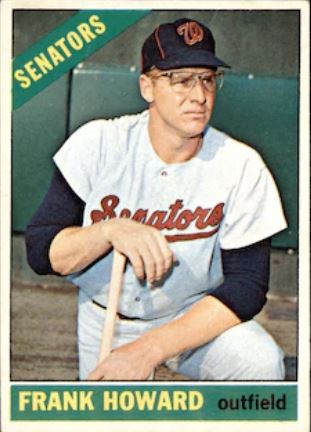
- He made his major-league debut on September 10, 1958, at Philadelphia’s Connie Mack Stadium. Batting against Robin Roberts, he finished 2-for-4, including a titanic two-run home run in his second big-league at-bat. The drive hit a billboard atop the leftfield roof, causing left-fielder Harry Anderson to say he was afraid the advertisement was going to fall over onto his head.
- He thundered a 450-feet upper-deck shot deep to left field to win the final game in the 1963 World Series for the Los Angeles Dodgers, who swept the New York Yankees in four games. Howard slugged .700 for the Series.
- In his only at-bat in the 1969 all-star game, he rapped a mammoth homer in front of his adoring hometown DC fans, including me.
-
In May 1968, the Senators’ most popular player went on a record-setting binge, smacking 10 homers in 20 at-bats over six games. The entire sports world was enthralled with the towering Senators’ slugger that week. He ranks amongst the top five home run hitters of the 1960s — with Hank Aaron, Harmon Killebrew, Willie Mays and Willie McCovey.
- During his career, he hit 17 round-trippers off Hall of Famers Whitey Ford, Bob Gibson, Catfish Hunter, Juan Marichal, Jim Palmer, Gaylord Perry, Robin Roberts, Warren Spahn and Hoyt Wilhelm.
- And in his final RFK Stadium at-bat in a Senators uniform on September 30, 1971, before a “crowd” of 14,460 despondent, irate fans due to the team’s pending move to Texas, Howard crushed a fastball into the leftfield stands. The fans, including me, showered our hero with a thunderous roar and a standing ovation (which included my tears) that went on for several minutes. Rounding the bases, Howard tipped his hat and flung it into the stands. My hero stood on the dugout’s top step, tears in his eyes, and blew a kiss to his adoring fans. After the game, Howard said it was “the biggest thrill” of his baseball career

September 30, 1971: Senators forfeit final home game in Washington, DC. Hondo Homers!
While not remembered as hitting for average, Howard hit .296 three separate times in his career, impressive numbers when batting titles were being won as low as Carl Yastrzemski’s .301 in 1968. He finished in the top ten in the league in batting average four separate times.
I was fortunate as a kid to be able to go to dozens of games each year thanks to our next-door neighbor, an usher at RFK Stadium who looked kindly at my passion for the team and the game. When I couldn’t get to the ballpark, nights found my small transistor radio tucked firmly under my pillow so that I could listen to Dan Daniels’ and John MacLean’s play-by-play broadcasts of Senators’ games on WTOP-AM radio. As I noted in a blog last year about my love for AM radio, I generally made it through five innings before nodding off. However, if it was an exciting ballgame and the Nats were still in it or if Howard was due up in the next half-inning, I’d sit up in my bed to stave off slumber and extend my listening time.
With Howard’s passing, the memories came rushing back …
- Of those 24 upper-deck seats at RFK Stadium, scattered from left field to straightaway center, painted white (several after being repaired) where mammoth Hondo homers came to a smashing rest.
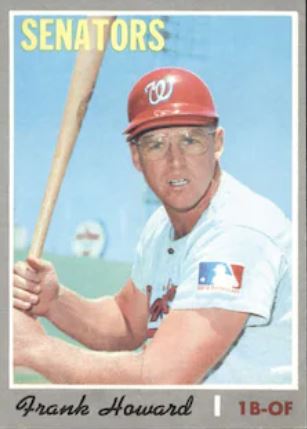
- Of those third-base coaches who would stand ridiculously waaayyy off the foul line in deference to Howard’s propensity for pulling line drives down the line, and of those third basemen, fearing the same scorching line drives, who played Howard on the infield edge of the leftfield grass. (In addition to this show of higher intelligence, the third-baggers knew that Hondo and his size 14D cleats was a lumbering giant, not built or noted for his speed.)
Like all of our heroes, Howard had his flaws. With his mighty swing came many Ks — he’s 79th on the all-time list of strikeouts (1,460 in 16 seasons). In the field, he was generally described as lumbering. Still, he played passable defense in leftfield (.975) and later at first base (.981). As noted above, he was built for power, not speed, as reflected in his lifetime total of eight stolen bases. He twice led the AL in grounding into double plays.
After his playing career, Howard became a minor league manager and later managed in the majors. Both of the teams he led — the San Diego Padres in 1981 and the New York Mets in 1983 — were in a rebuilding mode and struggled. As a teacher of the game, he related well to his young players. It’s not a coincidence that his two teams both made it to the World Series within three years of his departure … on the strength of their young talent.
He served as a coach for many years, including the Milwaukee Brewers from 1977-1980 and 1985-1986.
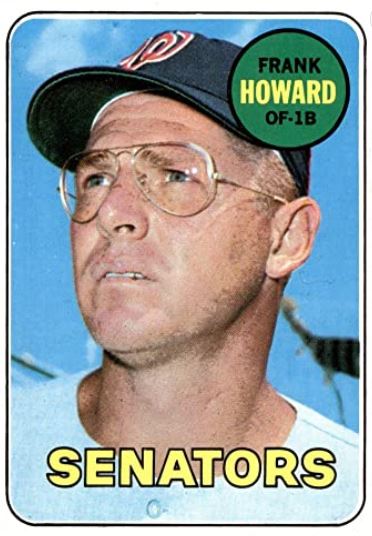
Of course, I wasn’t the only one who admired The Capital Punisher. An 8-foot tall bronze sculpture of Howard and his powerful swing stands alongside two of our National Pastimes’ all-time greats — Walter Johnson and Josh Gibson — in the Center Field Plaza at the Washington Nationals Park, honoring three icons of DC’s rich baseball history.
The images accompanying this blog are baseball cards I collected. Howard was my bigger-than-life hero — my Paul Bunyan, my John Wayne (another Hondo, coincidentally enough), my Superman, all rolled into one wowzer of a Man’s Man in the game that I will love to my dying day.
Thanks for the memories, Hondo. God Bless. I will never forget you.
********************************
Howard’s Notable Achievements:
• 1958 — MVP Three-I League, Green Bay Bluejays
• 1959 — Minor League Player of the Year, Victoria Rosebuds, Texas League & Spokane Indians, Pacific Coast League
• 1960 — NL Rookie of the Year
• 1960 — Topps All-Star Rookie Team
• 4-time AL All-Star (1968-1971)
• AL Slugging Percentage Leader (1968)
• 2-time AL Total Bases Leader (1968 & 1969)
• 2-time AL Home Run Leader (1968 & 1970)
• AL RBI Leader (1970)
• AL Bases on Balls Leader (1970)
• 20-Home Run Seasons — 10 (1960, 1962-1965 & 1967-1971)
• 30-Home Run Seasons — 5 (1962 & 1967-1970)
• 40 Home Run Seasons — 3 (1968-1970)
• 100 RBI Seasons — 4 (1962 & 1968-1970)
• 100 Runs Scored Seasons — 1 (1969)
• Won two World Series with the Los Angeles Dodgers (1959 & 1963)
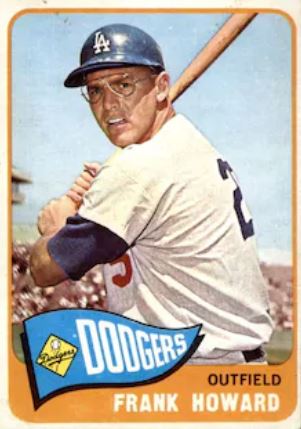

********************************
Addendum from LSomerbyCooke …
While I can still recite the backs of too many baseball cards, and while I was a voracious reader of The Washington Post’s sports section, including consuming its daily box scores, some of the particulars noted above concerning Howard’s career were unearthed at these terrific resources:
One last piece of Howard trivia … He played basketball at Ohio State University for three seasons, averaging 17.4 points per game. In 1956-57, he was voted All-Big Ten, 1st Team; in 1956-57, he was a Consensus All-America, 2nd Team; and in 1957-58, he was again All-Big Ten, 1st Team. He was selected by the Philadelphia Warriors in the 3rd round (5th pick, 21st overall) of the 1958 NBA draft. I’m glad that he was partial to baseball.
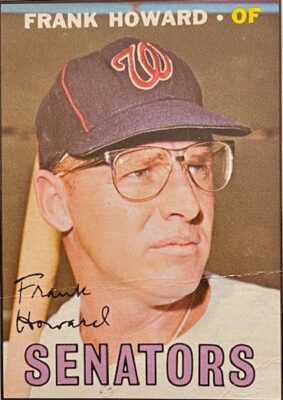
Subscribe to receive a heads-up of posts via email!
Gary McCorkle
I’ll never forget seeing Hondo play and loving seeing his upper-deck home runs, then coming back to see another game later in the season seeing the painted seats memorializing his blast! Forget the old “Kilroy was here,” Hondo crushing a homer here was more meaningful to me. As a diehard Yankee fan (Roger Maris remains my all-time favorite player), I cheered for the Senators to win every game except when they played my Bronx Bombers or if losing a game against another team was beneficial to my Yankees’ position in the AL standing. I loved seeing Howard and Mike Epstein at bat at the old RFK Stadium (DC Stadium when I saw my very first game in 1964)! Thanks again, Lee, for this wonderful trip down memory lane, and once again, you hit it out the ballpark! 😉⚾️
Gary McCorkle
P.S. – love the scorecard!!! ❤️⚾️
Dean Baretela
I remember as a Yankee Fan being in awe of the size and power of Frank Howard. Outside of Mantle and Maris, he was the most impressive ballplayer I saw that played in that era. A true legend of the game has passed. We all salute him as does anyone who is a true purist of the game.
Reed Sprague
Major League Baseball is a great game for kids, except that adults get involved from time to time to “help the game along.” I remember as a kid growing up in West Palm Beach, Florida, attending many Braves spring training games at West Palm Beach’s Municipal Stadium. Then, from 1969 to 1972, and again from 1981 to 1997, both the Braves and the Montreal Expos held spring training at Municipal Stadium. (The Expos held spring training there from 1969 to 1972 and again from 1981 to 1997. The Braves remained there from 1963 to 1997.) So, on and off for some twenty years altogether, two of the most popular MLB teams both held their spring training at West Palm Beach’s Municipal Stadium complex, sharing the facilities. Life could not have been better for us local kids. We lived each spring training day during that era in baseball heaven. It seemed to us that even adults could not ruin things for us.
But adults like to get involved, they like to tinker, and they always seem to have plans, even when their involvement, their tinkering or their plans are not needed.
Kids like me in the local West Palm Beach area from the mid ‘60s through the mid ‘90s were building many special memories even as the adults were “helping” (God bless them) to keep both teams at Municipal Stadium. But, in 1997, the adults in West Palm Beach achieved the impossible: They drove both teams out of Municipal Stadium in the same year. The adults had decided in the early to mid ‘90s to “fix the problem once and for all” by putting forth their best impression of an all-out effort to keep both teams. The result? Both teams left West Palm Beach’s Municipal Stadium for good in 1997. Arguably the most popular MLB team in America at that time (Braves) — certainly in the top five — and the MLB team with the most international appeal at that time, both gone in the same year. I was forty-two in 1997, but I was only eight when I was within sight of West Palm Beach’s Municipal Stadium anytime from 1963 to 1997.
Hank Aaron Drive once ran through the parking lot of Municipal Stadium and meant a great deal to us local kids. The road was a memorial to a living giant of a man, a man that we local kids saw very much up close each day for more than a decade during the spring seasons. We held our heads higher — much higher, in fact — when we rode our bikes on the side of his road. His road now runs meaninglessly along the edge of a Home Depot parking lot. Today’s kids probably don’t know why the road is even there. The stadium complex is long gone. The Home Depot squats in its place, probably brought to the site by the same adults who ran our teams out of town. A stadium complex that was very much alive with the simple dirt and grass of baseball for forty years was unceremoniously demolished in 2002 and replaced with dead concrete and asphalt.
I still love baseball, and I will always love baseball, regardless of what the adults do to harm the game. I could have stayed eight forever, though, if the adults hadn’t ruined it for me.
Your email address will not be published. Required fields are marked *
We want peace, cooperation, good health, equality, education, and opportunities. We want to be treated with respect and kindness.
Why is there so much division? I can’t comprehend why some folks don’t understand that it’s more important to be kind than to be correct. There needs to be less emphasis on winning at all costs and more emphasis on reaching mutually beneficial decisions. I genuinely believe we have the potential to do so much more of the latter.
While not remembered as hitting for average, Howard hit .296 three separate times in his career, impressive numbers when batting titles were being won as low as Carl Yastrzemski’s .301 in 1968. He finished in the top ten in the league in batting average four separate times.
